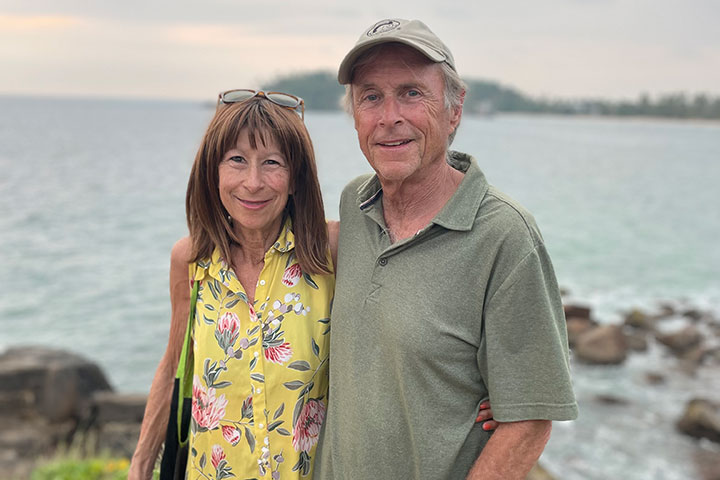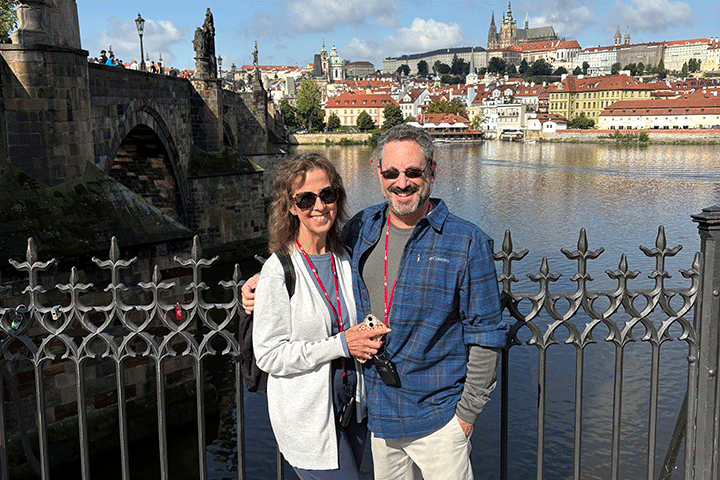A Second Opinion Felt Right

- IPMN turns to cancer
- Getting a second opinion
- FOLFIRINOX chemotherapy
- Whipple surgery
My journey with pancreatic cancer began in June 2021 when my asthma doctor scheduled a scan of my lungs.
A friend of mine insisted that I get checked out for a cough that had persisted a little too long. She thought I might have asthma. Neither one of us imagined that anything serious would come up. But then the radiologist found a tiny, precancerous cyst called an intraductal papillary mucinous neoplasm (IPMN) on my scan. I was shocked.
Following another CT scan and a special endoscopy, I found out on June 17, 2021, that I had stage I pancreatic adenocarcinoma. I was 68 years old at the time and had absolutely no symptoms. Fortunately, we caught it early and I consider myself exceptionally lucky for that.
Choosing Which Path to Follow
My gastroenterologist recommended a local surgeon in Boulder, Colorado, to remove the cyst. I live in Lafayette, which is only about 20 minutes from there, and I had always attended to my medical care in Boulder. But this path didn’t feel quite right.
It so happened that my brother was being treated for head and neck cancer at the University of Colorado Anschutz Medical Campus (Denver). Anschutz is well known as a teaching hospital, not to mention that they have several of the world’s top pancreatic cancer surgeons. They also have a clinic dedicated to pancreatic cysts like the one found in my initial scan. My brother urged me to get a second opinion there, and I am so glad that I did! Even though it’s twice the distance from my house, I ultimately knew that it was the right place for me.
Putting Together My Treatment Plan
The next phase of my journey moved fast. I met with my care team at CU Anschutz, including my oncologist Dr. Alexis Leal. Dr. Leal was already creating a plan with the CU Cancer Center tumor board, a group of multidisciplinary specialists that evaluate every cancer case at CU. After undergoing genetic testing, we learned that there were no genetic mutations in my tumor. I was relieved to find out that I don’t carry a mutation that could be passed on to my children.
We decided to proceed with four treatments of chemo, followed by a Whipple procedure, and then another eight rounds of chemo. The chemotherapy I was prescribed is a mixture of four drugs known collectively as FOLFIRINOX. I tolerated the side effects of the chemo quite well. I did lose most of my hair and I lost 34 pounds. But I was in it to win it, so I didn’t mind the drawbacks.
When I finished the four rounds of chemo I had the Whipple procedure, on September 8, 2021. This was during COVID-19, so the hospital was short-staffed and rooms were at a premium; I was out of the hospital in only six days.
Using Stage III Protocol for Stage I Cancer
No one on my care team wanted to cut any corners, least of all me. Even though I was diagnosed with stage I cancer, I underwent the same protocol as someone with stage III cancer. This meant that I had to complete the remaining eight rounds of chemo after the surgery. I’d be lying if I said it wasn’t hard. I was in recovery from my Whipple procedure and then began the chemo again, exactly six weeks after my surgery. But the post-surgical chemo gave us all confidence that every bit of cancer would be eliminated from my body—even fragments that may have been left behind after the procedure.
My final chemo treatment was on January 27, 2022, and it was cause for celebration. My tests have shown no signs of the disease since then.
Back to my Normal Life
I am doing really well. I have been taking international trips and living a completely normal and good life. I am filled with gratitude for the journey and all of the positive things that worked out. I look at the ups and downs of cancer treatment as being part of the overall process. Even though I was very fortunate to be diagnosed as a Ia in staging, I chose to maintain a positive outlook. It made a huge difference for everyone in my circle of family, friends, and community. I also chose to be open and upfront about what I was going through, which impacted those around me in a positive way.
I had a huge support system and community who helped me throughout my journey. I was able to impart my positive energy and it came back tenfold in support. I am a believer that it isn’t just the physical body that needs to be considered in a cancer diagnosis, but also the whole being; the mental, emotional, and spiritual bodies are just as important. I knew I was in the right place in my hospital choice in Denver and could put my trust in the professionals there. I trusted their decisions for my treatment and never had to second-guess myself.
As for that persistent cough that brought me into the radiologist in the first place . . . . That turned out to be a post-nasal drip. I am grateful that that was the catalyst that led to my eventual diagnosis.






